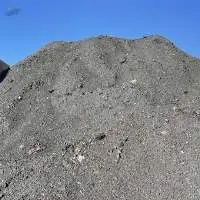
We hold immense expertise in making available Copper in many forms including LME registered and non registered cathodes, billets, rods, cakes, bars, foil, sheet, granules, plates, powder, shot, turnings, wire, insulated wire, mesh and “evaporation slugs”. Copper is one of the most important metals. Copper is reddish with a bright metallic lustre. It is malleable, ductile, and a good conductor of heat and electricity (second only to silver in electrical conductivity). Its alloys, brass and bronze, are very important. Monel and gun metals also contain copper. The most important compounds are the oxide and the sulphate, (blue vitriol
The Incinerated scrap or E46, is the by-product derived from the reprocessing of incinerated domestic waste. After the combustion process, the furnace output (IBA Incinerator bottom ash) is firstly washed, magnetically separated and screened to separate any no ferrous material. At a visual inspection, the material is fragmentized, with iron and steel parts, resulting partly cut or in shredded form. The stock appears heterogeneous and contains all kind of cut or dismantled steel parts such as sheets, bars, frames, wires, bolts and other iron/steel household residues. The incinerated scrap is eventually oxidized, due to the thermal and cooling treatments, that the material has been submitted to. The burnt scrap also contains minor slag parts, ash and iron oxide, due to the recovery process. Such components are inherent and adhere to the scrap surface. The total impurities, can be sorted, but not fully removed. The consignment does not contain any type of arms, ammunition, mines, shells, cartridges, radioactive contaminated, or any other explosive material in any form either used or otherwise. The collected stock, is stored in open air, on cemented flooring. It can be loaded loose in 20â?? heavy duty container. Please feel free to contact us for further details.
We are glad to propose 500 MT of stain less steel mill scale. Mill scale is formed on the outer surfaces during by the hot rolling lamination of stainless-steel products. At a visual inspection the material is a hard brittle sand and is mainly composed of iron oxides, mostly ferric, and is bluish black in colour, but it also contains considerable alloying elements such as chromium and nickel. The recovery ratio after melting in furnace for the most valuable alloy elements is: - Ni: 3.5 - 4.5% - Cr: 6-8% From the chemical and physical analysis performed on the scrap, and according to the European environmental rules, the material has been classified as a special non dangerous waste, listed in green list. In particular the mill scale can be classified as follows: Waste code: 10 02 10 The material is stored on cemented flooring, and it can be loaded loose in tipper trucks or containers. Chemical analysis of the material is available on request.
We offer a wide plethora of Zinc in many forms including LME registered and non registered Special High Grade Ingots and Jumbos, cathodes, dust, foil, granules, powder, pieces, anodize activated powder, shot, and a mossy form. Zinc is a bluish-white, lustrous metal. It is brittle at ambient temperatures but is malleable at 100 to 150°C. It is a reasonable conductor of electricity, and burns in air at high red heat with evolution of white clouds of the oxide. Plating thin layers of zinc on to iron or steel is known as galvanizing and helps to protect the iron from corrosion.
Fly ash is a by-product produced while burning finely ground coal in a boiler to produce electricity. It is removed from the plant exhaust gases primarily by electrostatic precipitators or baghouses and secondarily by scrubber systems. Physically, fly ash is a very fine, powdery material, composed mostly of silica. Nearly all particles are spherical in shape. Fly ash is a pozzolan, a siliceous material which in the presence of water will react with calcium hydroxide at ordinary temperatures to produce cementitious compounds. SiO2, Al2O3, Fe2O3 and occasionally CaO are the main chemical components present in fly ashes. Fly ash significantly improves concrete performance in different ways and also provides many benefits in cement and non-cement applications. Fly Ash colour can vary from grey and dark grey, yellowish tan and light to brownish. ADVANTAGES OF FLY ASH IN CONCRETE Fly Ash is a Pozzolan Improves concrete workability and lowers water demand Sulfate and Alkali Aggregate Resistancet Rise in compressive strength over time Environment friendly CEMENTATION Fly Ash is optimized for its fineness while reducing the water demand and improving the chemical compositions to maximise its benefits when used in concrete. Fly-ash can also be used as an add-on to concrete mixture with pozzolanic and/or latent hydraulic properties. We at CEMENTATION selectively collect fly ash and subject to rigorous testing, further refines these collected materials to produce quality fly ash products meeting the needs of our customers.
We deals in the following Chemicals :- Fly Ash Powder Ilmenite (Synthetic Rutile) Hematite / Iron Oxide Powder, Iron Oxide ( Ferric Oxide ) Barite Powder, Barite Ore Dolomite Powder Mica Powder, Mica Flakes, Mica Blocks, Mica Sheets Quartz / Silica Powder, Quartz / Silica Lumps, Quartz / Silica Granules, Quartz / Silica Grits Bentonite Powder, Bentonite Lumps, Bentonite Granules, Bentonite Clay Alumina Silica ( Cenosphere ) Powder Calcium Carbonate Powder Magnetite, Cellulose Fibers, Cellophane Flakes, Walnut Shells
Fly Ash Minimum Quantity - 1 Ship load (30,000 MT) Payment Term - L/C
Supplier: Fly ash, granulated iron blast furnace slag (gbfs), potassium feldspar , sodium feldspar , stpp sodium tripolyphosphate, zirconium silicates & zirconium flours




